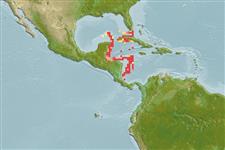Common names from other countries
>
Ophidiiformes (Cusk eels) >
Ophidiidae (Cusk-eels) > Ophidiinae
Etymology: Lepophidium: Latin, lepus, leporis = rabbit + Greek, ophis = serpent (Ref. 45335).
More on author: Robins.
Environment: milieu / climate zone / depth range / distribution range
Ekologi
marina djupbottenlevande; djupintervall 180 - 485 m (Ref. 34024). Deep-water; 25°N - 10°N, 90°W - 80°W (Ref. 91765)
Western Atlantic: apparently restricted to the deep bank area east and northeast of Nicaragua and Honduras in the western Caribbean Sea and north of the Yucatan Peninsula in the southern Gulf of Mexico; not in the eastern Gulf of Mexico.
Size / Vikt / Age
Maturity: Lm ? range ? - ? cm
Max length : 27.3 cm SL hane/ej könsbestämd; (Ref. 91765)
Short description
Bestämningsnycklar | Morfologi | Morfometri
Mjukstrålar i ryggfenan (totalt) : 140 - 147; Mjukstrålar i analfenan: 120 - 125; Ryggkotor: 80 - 83. This species is characterized by the following: usual number of vertebrae, precaudal 14-15, caudal 65-67, total 81-82 (80-83); usual number of fin rays, dorsal 142-145 (140-147), anal 120-125, pectoral 22-23); pyloric caeca usually 3 (rarely 4), 2 (rarely 3) in a single whorl, 1 in 2nd tier; first gill arch with rudimentary rakers 4 (rarely 3) on the upper arm, 8 developed (rarely 7) developed rakers on the lower limb, 0-3 (usually 0) rudimentary rakers anteriorly on the first arch; total rakers 12 (usually 11-14); dorsal-fin origin between neural spines 4-5 (11 specimens) or 5-6 (6 specimens) (Ref. 91765).
Rare species (Ref. 34024). Reproductive strategy possibly similar to other members of this family featuring oviparity, with oval pelagic eggs floating in a gelatinous mass (Ref. 205).
Life cycle and mating behavior
Maturities | Reproduktion | Spawnings | Egg(s) | Fecundities | Larver
Robins, C.R., R.H. Robins and M.E. Brown, 2012. A revision of Lepophidium (Teleoastei, Ophidiidae), with descriptions of eight new species. Bulletin of the Florida Museum of Natural History 52(1):1-94. (Ref. 91765)
IUCN Red List Status (Ref. 130435)
CITES (Ref. 128078)
Not Evaluated
Threat to humans
Harmless
Human uses
Verktyg
Special reports
Download XML
Internet-källor
Estimates based on models
Preferred temperature (Ref.
115969): 13.8 - 20.6, mean 17.7 (based on 7 cells).
Phylogenetic diversity index (Ref.
82804): PD
50 = 0.5000 [Uniqueness, from 0.5 = low to 2.0 = high].
Bayesian length-weight: a=0.00102 (0.00046 - 0.00225), b=3.06 (2.88 - 3.24), in cm Total Length, based on all LWR estimates for this body shape (Ref.
93245).
Trofisk nivå (Ref.
69278): 3.6 ±0.7 se; based on size and trophs of closest relatives
Resiliens (Ref.
120179): Mellan, lägsta populationsfördubblingstid 1,4-4,4 år (Assuming tmax>3).
Fishing Vulnerability (Ref.
59153): Low vulnerability (23 of 100).
